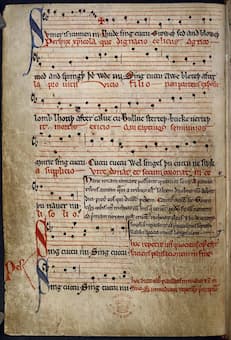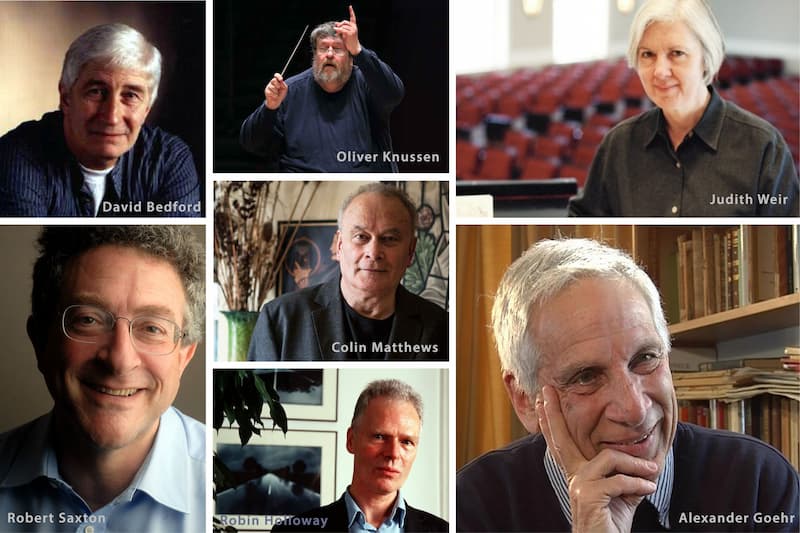Collaborative Variations on Sumer is icumen in

Sumer is icumen in, Harley MS 978, f. 11v
(London: British Library)
Written in the Wessex dialect of Middle English, the 13th century song Sumer is icumen in welcomes the warmest season with open arms. The cuckoo is called on to sing, the seeds are springing from the ground, the meadow is in flower, the trees are clothed in leaves again. Animals call after their young, cows are dancing, and the cuckoo sings on.
The song is a rota, a kind of round. The first singer starts and then he gets to the red cross mark in the first line, the second singer starts, and so on. In addition, at the bottom of the page, where it says ‘Pes’ in the left margin, we have two more voices who sing these lines repeatedly until the top voices stop.
In the box, three-quarters of the way down the page, there are instructions on how to sing this:
Four companions can sing this round. But it should not be sung by fewer than three, or at the very least, two in addition to those who sing the pes. This is how it is sung. While all the others are silent, one person begins at the same time as those who sing the ground. And when he comes to the first note after the cross, another singer is to begin, and thus for the others. Each shall observe the written rests for the space of one long note [triplet], but not elsewhere.
The Latin text written in red below the Wessex Middle English is a contrafactum, a later text added to preexisting music – in this case, adding a religious text about the crucifixion to the preexisting rota. The Pes text doesn’t appear to have been changed.
Anonymous: Sumer is icumen in (Deller Consort)
How do we bring this to the modern day?
For the 40th anniversary of the Aldeburgh Festival in 1987, the artistic directors of the Festival decided to revive the idea of collaborative variations, where a number of different composers get together to create a variation set. The English composers David Bedford, Alexander Goehr, Robin Holloway, Oliver Knussen, Colin Matthews, Robert Saxton, and Judith Weir created a composite work based on Sumer is icumen in. The use of this melody came from the quotation of the work by Benjamin Britten in the finale of his Spring Symphony at 06:40.
Benjamin Britten: Spring Symphony, Op. 44 – Part IV: Finale (Martyn Hill, tenor; Elizabeth Gale, soprano; Alfreda Hodgson, contralto; London Symphony Chorus; Southend Boys Choir; London Symphony Orchestra; Richard Hickox, cond.)

Each composer approached the work in an individual manner. We start with Oliver Knussen giving us the melody, starting with a very spring-like opening with twittering birds and the like. Finally, at 00:47, the Pes starts.
Bedford / Goehr / Holloway / Knussen / Matthews / Saxton / Weir: Variations on Sumer is icumen in: Theme (Oliver Knussen) (BBC Symphony Orchestra; Jac van Steen, cond.)
Robert Saxton changes the century immediately with his ‘whirling hexachords’.
Bedford / Goehr / Holloway / Knussen / Matthews / Saxton / Weir: Variations on Sumer is icumen in – Variation 1 (Robert Saxton) (BBC Symphony Orchestra; Jac van Steen, cond.)
Robin Holloway gives us a movement that feels like the expressive melancholy of Delius.
Bedford / Goehr / Holloway / Knussen / Matthews / Saxton / Weir: Variations on Sumer is icumen in – Variation 2 (Robin Holloway) (BBC Symphony Orchestra; Jac van Steen, cond.)
Scottish mannerisms in Judith Weir’s Variation 3 recall the drones and parallel lines of bagpipe music, with an oboe solo that evolves into pattering strings.
Bedford / Goehr / Holloway / Knussen / Matthews / Saxton / Weir: Variations on Sumer is icumen in – Variation 3 (Judith Weir) (BBC Symphony Orchestra; Jac van Steen, cond.)
In Variation 4, the longest section, you hear a lonely bird’s song and some distant horn calls. Summer seems more like a memory, rather than a celebrated season. Goehr later expanded on his variation to add two more movements to create Still Lands (1990).
Bedford / Goehr / Holloway / Knussen / Matthews / Saxton / Weir: Variations on Sumer is icumen in – Variation 4 (Alexander Goehr) (BBC Symphony Orchestra; Jac van Steen, cond.)
Colin Matthews’ Variation 5 takes us out of Goehr’s wilderness into an expressionistic machine.
Bedford / Goehr / Holloway / Knussen / Matthews / Saxton / Weir: Variations on Sumer is icumen in – Variation 5 (Colin Matthews) (BBC Symphony Orchestra; Jac van Steen, cond.)
All is restored at the end with David Bedford’s finale, which not only restores the original tune but also combines it with the round Old Joe Has Gone Fishing from Peter Grimes. Thus, the original inspiration came from Britten and returns to him in the end.
Bedford / Goehr / Holloway / Knussen / Matthews / Saxton / Weir: Variations on Sumer is icumen in – Finale (David Bedford) (BBC Symphony Orchestra; Jac van Steen, cond.)
In this neat set of collaborative variations, we get, on one hand, the 13th-century original, still operating like a never-ceasing and perpetual canon, while on the other hand, we have an extraordinary overview of the variety of British composition in the 20th century.
For more of the best in classical music, sign up to our E-Newsletter



English Folk Project do a jaunty version with drum and recorder on their YouTube channel. Mediaeval English Folk Song – Sumer Is Icumen In
https://www.youtube.com/watch?v=gMCPFA_s0TI